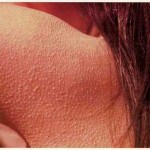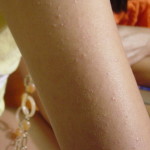 Have you ever wondered about those little bumps on the back of your arms or legs that never seem to go away but sometimes can be itchy or even make you think twice about bearing your skin to the world? Maybe you have a friend who has complained about this? Well, it is likely that you fall in to one of the two situations because this “goose flesh” condition effects about half of the population and is officially called Keratosis Pilaris, or K.P. for short. While it can be as mild as the minor irritation I mentioned above it can also be severe and cause a great deal of pain and unhappiness to those who suffer from it. The condition has a genetic component but environmental factors can contribute to the degree of severity. Keratosis pilaris bumps are usually white, sometimes red, and generally don’t hurt or itch, although they can in severe cases. Some signs and symptoms of K.P.:
Have you ever wondered about those little bumps on the back of your arms or legs that never seem to go away but sometimes can be itchy or even make you think twice about bearing your skin to the world? Maybe you have a friend who has complained about this? Well, it is likely that you fall in to one of the two situations because this “goose flesh” condition effects about half of the population and is officially called Keratosis Pilaris, or K.P. for short. While it can be as mild as the minor irritation I mentioned above it can also be severe and cause a great deal of pain and unhappiness to those who suffer from it. The condition has a genetic component but environmental factors can contribute to the degree of severity. Keratosis pilaris bumps are usually white, sometimes red, and generally don’t hurt or itch, although they can in severe cases. Some signs and symptoms of K.P.:
- Small white or red bumps, typically on the upper arms, legs, buttocks or cheeks
- Dry, rough and sometimes itchy skin in the areas with bumps
- Worsening in winter, when humidity is low and skin tends to be drier
- Keratosis pilaris may be limited to individual, sandpaper-like bumps resembling goose flesh
- In some cases, the bumps may become inflamed & even cause scarring, especially on the face
Even so, it K.P. isn’t often a serious health threat and usually gradually disappears by age 30 on its own, though again, not always. This bumpy skin condition results from the buildup of keratin — a hard protein that protects your skin and other epithelial surfaces of the intestines and eyes – from harmful substances and infection. In these cases though the keratin forms a scaly plug that blocks the opening of the hair follicle. The number of plugs that form vary, causing patches of rough skin. Why this build up of keratin occurs is unknown. But often there is a genetic predisposition or association with other skin conditions, like atopic dermatitis. If it is a big problem, seeing a dermatologist is a good idea as there are urea containing creams and other topical solutions that can help reduce the appearance of the condition. Vitamin A deficiency can also be a factor and supplementing with Vitamin A has been shown to be of help to some. Vitamin A is a fat-soluble vitamin so always has to be monitored as it can be overdosed. Generally, the Vitamin A Reccomened Daily Allowance (RDA) is:
- 1,000 RE for men (5,000 IU) and
- 800 RE for women (4,000 IU) or 1000 RE during pregnancy and 1200 RE during lactation. RE = retinol equivalents IU = international units
If you would like to see if your K.P. can be improved with dietary changes, try increasing your Vitamin A intake for 6 weeks and see if symptoms decrease. Take a picture of the affected area on day one, and then again after four weeks to see if there has been any change. Incorporate some gentle exfoliation or “dry brushing” to help with eliminating the old Keratin plugs.
To increase Vitamin A / Retinol / beta carotene, try eating daily two or more of the following:
- 1 whole carrot (chew slowly or steam it and then chew well) = 11,000 IU Retinol
- 1 med sweet potato = 12,000 IU Retinol
- Carrot juice 1 cup = 120,000 IU
- Spinach, steamed, ½ cup = 7,300 IU Retinol
- Apricots, med size, 10 halves = 6,000
For more good sources of Vitamin A or Beta Carotene or Retinol see: http://www.healthaliciousness.com/articles/natural-food-sources-of-beta-carotene.php
For more information about how to potentially reduce KP see:
http://www.doctoroz.com/blog/audrey-kunin-md/treating-chicken-skin-bumps-keratosis-pilaris
For more information about the amazing phenomenon of dry brushing see:

